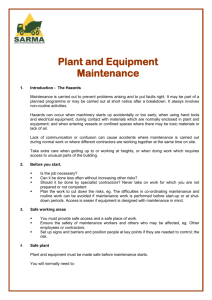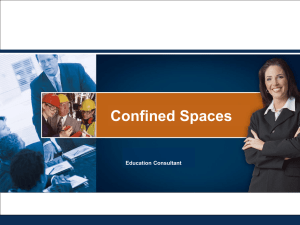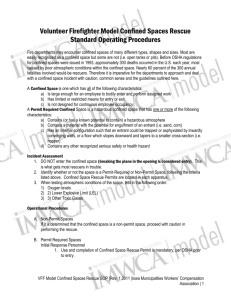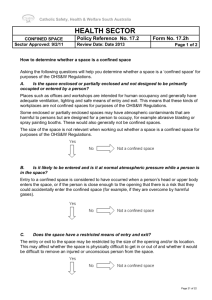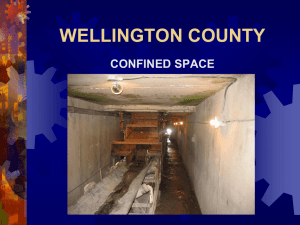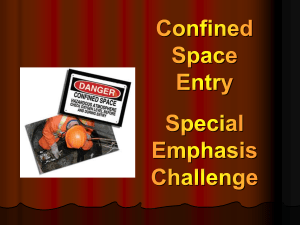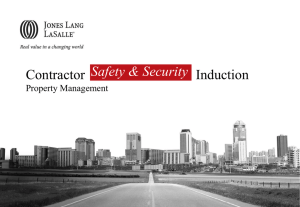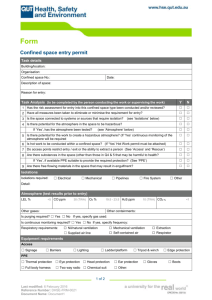confined spaces
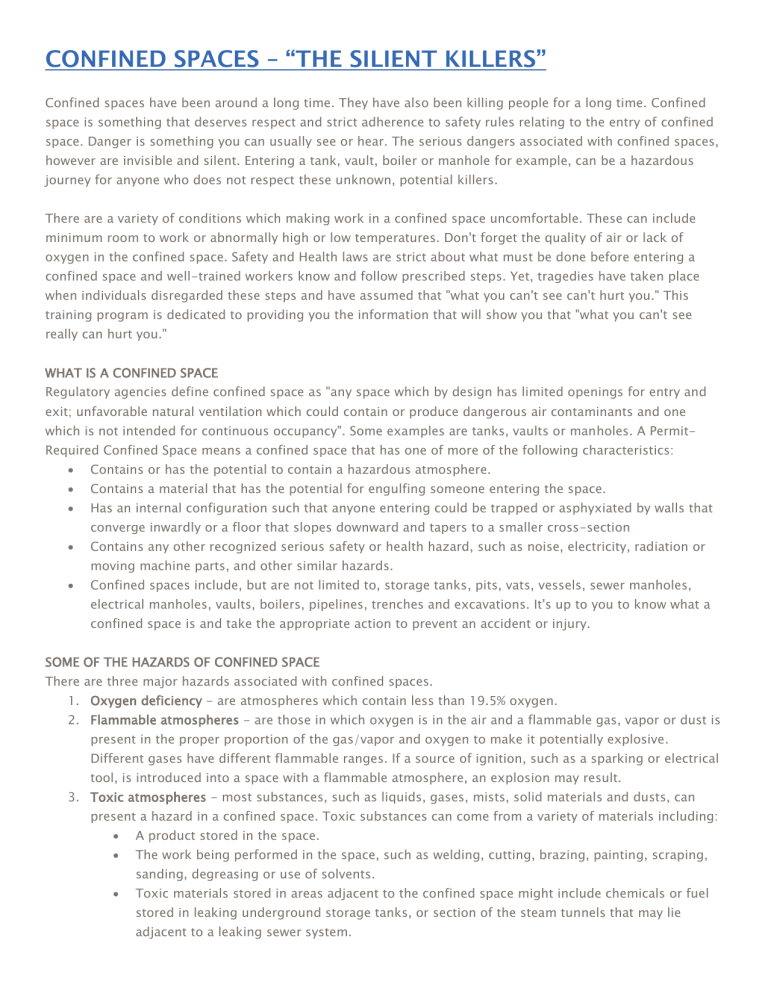
CONFINED SPACES – “THE SILIENT KILLERS”
Confined spaces have been around a long time. They have also been killing people for a long time. Confined space is something that deserves respect and strict adherence to safety rules relating to the entry of confined space. Danger is something you can usually see or hear. The serious dangers associated with confined spaces, however are invisible and silent. Entering a tank, vault, boiler or manhole for example, can be a hazardous journey for anyone who does not respect these unknown, potential killers.
There are a variety of conditions which making work in a confined space uncomfortable. These can include minimum room to work or abnormally high or low temperatures. Don't forget the quality of air or lack of oxygen in the confined space. Safety and Health laws are strict about what must be done before entering a confined space and well-trained workers know and follow prescribed steps. Yet, tragedies have taken place when individuals disregarded these steps and have assumed that "what you can't see can't hurt you." This training program is dedicated to providing you the information that will show you that "what you can't see really can hurt you."
WHAT IS A CONFINED SPACE
Regulatory agencies define confined space as "any space which by design has limited openings for entry and exit; unfavorable natural ventilation which could contain or produce dangerous air contaminants and one which is not intended for continuous occupancy". Some examples are tanks, vaults or manholes. A Permit-
Required Confined Space means a confined space that has one of more of the following characteristics:
Contains or has the potential to contain a hazardous atmosphere.
Contains a material that has the potential for engulfing someone entering the space.
Has an internal configuration such that anyone entering could be trapped or asphyxiated by walls that converge inwardly or a floor that slopes downward and tapers to a smaller cross-section
Contains any other recognized serious safety or health hazard, such as noise, electricity, radiation or moving machine parts, and other similar hazards.
Confined spaces include, but are not limited to, storage tanks, pits, vats, vessels, sewer manholes, electrical manholes, vaults, boilers, pipelines, trenches and excavations. It's up to you to know what a confined space is and take the appropriate action to prevent an accident or injury.
SOME OF THE HAZARDS OF CONFINED SPACE
There are three major hazards associated with confined spaces.
1.
Oxygen deficiency - are atmospheres which contain less than 19.5% oxygen.
2.
Flammable atmospheres - are those in which oxygen is in the air and a flammable gas, vapor or dust is present in the proper proportion of the gas/vapor and oxygen to make it potentially explosive.
Different gases have different flammable ranges. If a source of ignition, such as a sparking or electrical tool, is introduced into a space with a flammable atmosphere, an explosion may result.
3.
Toxic atmospheres - most substances, such as liquids, gases, mists, solid materials and dusts, can present a hazard in a confined space. Toxic substances can come from a variety of materials including:
A product stored in the space.
The work being performed in the space, such as welding, cutting, brazing, painting, scraping, sanding, degreasing or use of solvents.
Toxic materials stored in areas adjacent to the confined space might include chemicals or fuel stored in leaking underground storage tanks, or section of the steam tunnels that may lie adjacent to a leaking sewer system.
There are of course, additional potential hazards such as spaces with high temperatures, excessively noisy areas, chemical piping, steam lines and others. All potential safety hazards must be evaluated and proper protection provided for each type of hazard to ensure confined space safety.
SOME DEFINITIONS
As with any training program and necessary policies and procedures, there are many terms and definitions.
Let's take a look at some terms used when discussing confined spaces.
Attendant - an individual stationed outside the permit spaces who monitors the authorized entrants and who performs attendant's duties as required. Note, we did not say performs rescue services. An attendant is not authorized to enter the confined space under any circumstance, unless that person is also trained and an authorized rescue person, with appropriate rescue equipment.
Inerting - the displacement of the atmosphere in a space by a noncombustible gas, such as nitrogen, to such an extent that the resulting atmosphere is noncombustible. Keep in mind that although inerting has made the space noncombustible, it has also made it oxygen deficient. This means that the space may then be entered only by entrants using self-contained breathing apparatus.
Zero mechanical state - the mechanical potential energy of all portions of machinery or equipment is set so that the opening of the pipes, tubes, hoses or actuation of any valve, lever or button will not produce a movement which could cause injury. This takes place during a lockout/tagout procedure and zero mechanical state means that the equipment is fully locked out from any unintentional operation.
Engulfment - the surrounding of a person by finely divided solids or a liquid. A worker in a storage tank filled with sawdust could fall into an air pocket, be completely surrounded by sawdust and suffocate to death. That's an example of engulfment.
Hot work permit - the employer's written authorization to perform operations such as welding, cutting, brazing or other "hot work" that could provide an ignition source.
A "non-permit confined space" - is one that does not have or contain the potential to contain any hazard capable of causing death or serious physical harm.
Rescue team - those persons whom the employer has designated prior to any permit-required confined space entry to perform rescues from confined spaces.
There are many more definitions and important procedures to learn about confined spaces, but this provides you an insight into some confined space terminology. Knowledge is one of the most important aspects of safety in a confined space environment. What you don't know can kill you.
WHAT MAKES A SAFE CONFINED SPACE
A trained person must always test a confined space's atmosphere before anyone enters. How do you know if you don't test the atmosphere? If the oxygen, toxicity or flammable limits create a hazard, then the confined space is unsafe to enter. You can't tell by looking or sniffing…the atmosphere must be tested. Many people have died because people have ignored atmosphere testing or they weren't prepared for the serious hazards involved. The same applies to rescue. When a person in a confined space is overcome by oxygen deficiency, toxic vapors or gases, what is the first reaction of the people standing by for rescue? The first reaction is to go get the downed person. If you are an attendant standing by, your duty is to observe and assist from above. If you have a tag line on the person inside and can pull them out without entering the confined space, that's your job. If you have the proper equipment, ok, but at no time should you enter the confined space for any reason. Only properly trained and equipped rescue personnel may enter a confined space for rescue.
HAZARDOUS ATMOSPHERES IN CONFINED SPACES
People enter confined spaces for a variety of reasons, including testing, repairs, inspections and cleaning. A confined space is any area that:
Has a limited opening for entry and exit.
May contain or produce toxic air contaminants.
Has a high concentration of an inert gas.
Is not intended for continuous occupancy.
May have an oxygen-deficient atmosphere.
All such spaces must be analyzed and tested before entry. Workers should also be trained to understand the hazards that may be found in these spaces. A few of the potentially hazardous gases are:
Carbon monoxide - this gas is usually produced by the exhaust of an engine or heater. It is colorless, odorless, tasteless and deadly. If the air you breathe contains carbon monoxide, the gas interferes with your body's ability to utilize the oxygen in your lungs. You can still breathe, but it does not do you any good. It's deadly.
Hydrogen sulfide - this is the colorless gas with a rotten egg smell. You may think the smell would give you plenty of warning, but it doesn't. After a whiff or two, in higher concentrations, the gas can desensitize your sense of smell. In extremely high concentrations, one or two whiffs if enough to kill you. Hydrogen sulfide is released during the decay of organic matter found in mud, sewage and is often present in oil and gas drilling.
Carbon dioxide - decaying animal or vegetable matter can create this gas. It could also be leaked from a fire suppression system or it may have been used to make inert, a space. The gas is odorless, colorless and displaces oxygen within a space, which can be fatal.
Welding gases - Acetylene, oxygen, argon and helium are all gases used in welding that might find their way into a confined space. Each has different hazards and characteristics. This is another reason why testing of the atmosphere is so important. You never know the atmospheric hazard unless you test the air.
THE IMPORTANT JOB OF TESTING ATMOSPHERES
Testing is required for evaluation of hazards and verification that acceptable entry conditions into the space exists.
Evaluation Testing - the atmosphere of a confined space should be analyzed using equipment of sufficient sensitivity and specificity to identify and evaluate any hazardous atmospheres that may exist.
Evaluation testing is usually done with certified and qualified professionals.
Verification Testing - The atmosphere of a permit space which may contain a hazardous atmosphere should be tested for residues of all contaminants identified by evaluation testing to make sure the entry atmospheres meet safety standards derived in evaluation testing.
Testing Duration - Each test equipment manufacturer has measurement values for each test or potential hazard for which you are testing. Be sure to follow the equipment manufacturer's requirements.
Testing of Stratified Atmospheres - When monitoring for entries involving a descent into atmospheres that may be stratified, the atmosphere should be tested a distance of 4 feet in the direction of travel and to each side. A stratified atmosphere is one where there may be several layers of air inside the space. Some gases or vapors rise to certain levels, others may descend toward the ground. It's imperative that tests include all layers of the air or atmosphere in a confined space.
Order of Testing - A test for oxygen is performed first because most combustible gas meters are oxygen dependent and will not provide reliable readings in an oxygen deficient atmosphere.
Combustible gases are tested next, because the threat of fire or explosion is both more immediate and more life threatening. Exposure to toxic gases and vapors may be required and these tests should be performed last.
ATTENDANT TRAINING
As stated earlier, training is very important and the knowledge you have can save your life. All personnel involved in entry into a permit-required confined space should receive appropriate training, as required by their organization. Typically, the training should include the requirements of the program and entry conditions, as established by your company. Training in the conditions or work practices that may produce a hazard in a non-permit confined space that may require that the space be reevaluated by the Supervisor prior to entry. Training on hazard recognition and use of atmospheric testing devices, including information on the mode, signs, symptoms and consequences of exposure.
Training should include the use of personal protective equipment including rescue harnesses, respiratory protection and similar required equipment. Certainly, training in proper entry procedures and precautions should include maintaining communications with the attendant as necessary to enable the attendant to monitor entrant status and to enable the attendant to alert entrants of the need to evacuate the space. Alerting the attendant whenever the entrant recognizes any warning sign or symptoms of exposure to a dangerous situation or the entrant detects a prohibited condition.
Training in evacuation is necessary so both the entrant and attendant receive an evacuation order, or the entrant recognizes any warning sign or symptom of exposure to a dangerous situation. There must be training in the emergency and non-entry rescue methods and procedures for calling rescue services. The attendant, in addition to the training just listed, should receive training in the hazards that may be faced during entry, including information on the mode, signs or symptoms and consequences of the exposure. Additionally, training is required in the behavioral effects of hazard exposure in authorized entrants.
Additional training and responsibilities of attendants should include a constant maintenance of an accurate count of authorized entrants in the permit space and ensure that the means used to identify authorized entrants accurately identifies who is in the permit space. The attendant should remain outside the permit space during entry operations until relieved by another attendant. Communicate with authorized entrants as necessary to monitor entrant status and to alert entrants of the need to evacuate the space. The attendant monitors the activities inside and outside the space to determine if it's safe for entrants to remain in the space. The attendant may also order the authorized entrants to evacuate the permit space immediately under the following conditions:
If the attendant detects a prohibited condition.
If the attendant detects behavioral effects of hazard exposure in the authorized entrants.
If the attendant detects a situation outside the space that could endanger the authorized entrant or;
If the attendant cannot effectively and safely perform the requirements of this job.
The attendant may summon rescue and other emergency services as soon as the attendant determines that authorized entrants may need assistance to escape from permit space hazards. Also, the attendant warns unauthorized persons to stay away from the permit space and generally controls the space. The attendant has specific work assignments established for this job, but does not perform any duties that might interfere with
the primary duty, which is to monitor and protect the authorized entrants or other duties established by company policies and procedures.
One of the most important lessons to be learned by attendants is they do not enter the confined space at any time, for any reason. Attendants are there for monitoring, observing and protecting the entrants. They cannot be distracted from this responsibility and generally are not trained or equipped for rescue services. Too many people have died trying to rescue people from confined spaces. Attendants, do not attempt rescue, under any circumstances. Call for help and let the professionals make the rescue.
Confined space work is safe…IF YOU FOLLOW THE RULES. If you ignore rules or take short cuts you're playing with death. Knowledge, training, proper equipment and of course, following the proper procedures will ensure your safety and the safety of everyone working in, around or near confined spaces.
